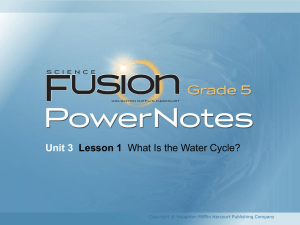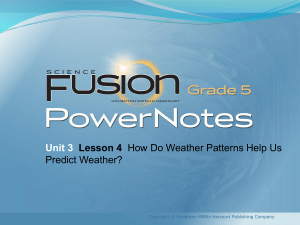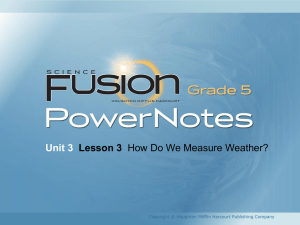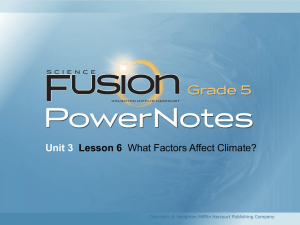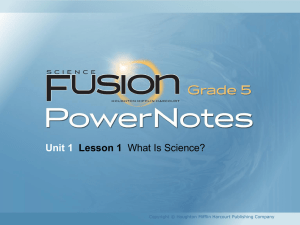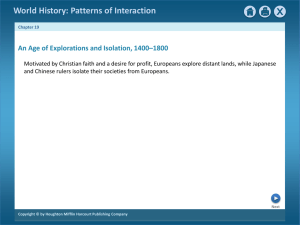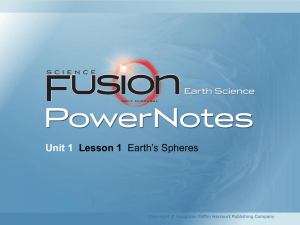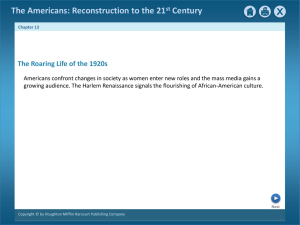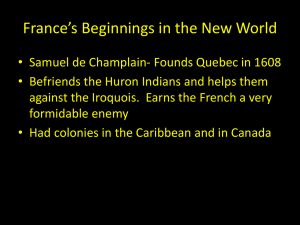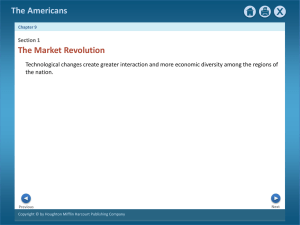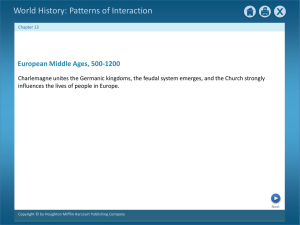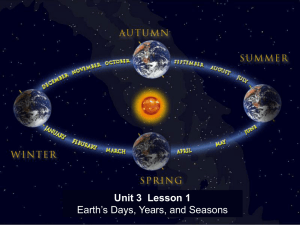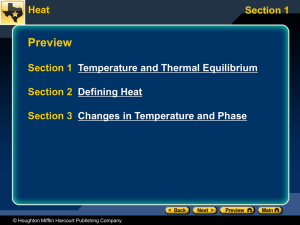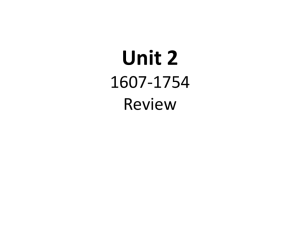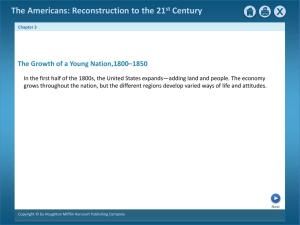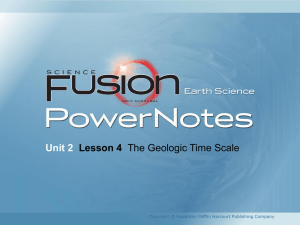01.2 Fusion Oceans Weather - Lesson 1 Wind - cms14-15
advertisement
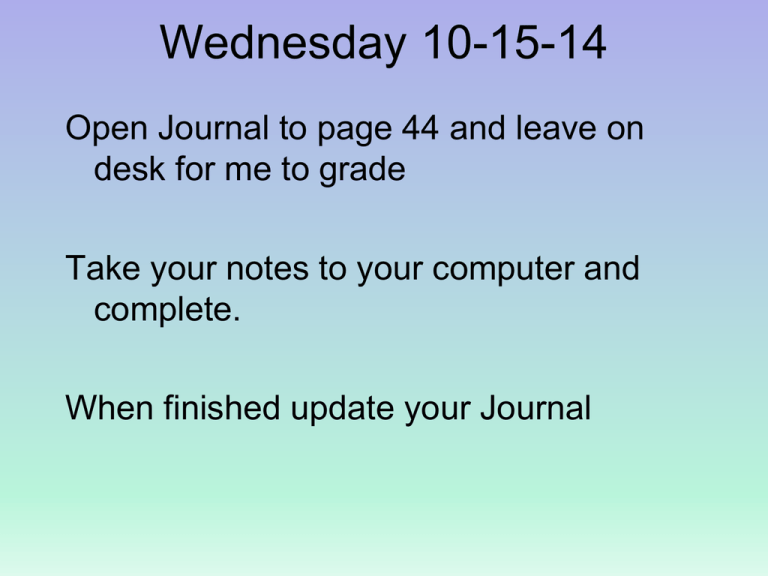
Wednesday 10-15-14 Open Journal to page 44 and leave on desk for me to grade Take your notes to your computer and complete. When finished update your Journal Unit 8 Lesson 1 Wind in the Atmosphere Copyright © Houghton Mifflin Harcourt Publishing Company Unit 8 Lesson 1 Wind in the Atmosphere Blow It Out! What causes wind? The uneven heating of Earth’s surface by the sun causes temperature differences in the air. Copyright © Houghton Mifflin Harcourt Publishing Company Unit 8 Lesson 1 Wind in the Atmosphere Blow It Out! What causes wind? • Warm air rises, creating areas of low pressure. Cool air sinks, creating areas of high pressure. • Air moves from areas of higher pressure toward areas of lower pressure. Copyright © Houghton Mifflin Harcourt Publishing Company Unit 8 Lesson 1 Wind in the Atmosphere What causes wind? • Wind is the movement of air caused by differences in air pressure. • Cold air at the poles creates areas of high pressure there. Warm air at the equator creates an area of lower pressure. • Globally, air moves in circular patterns called convection cells. Convection cells occur at about every 30°of latitude, producing pressure belts. Copyright © Houghton Mifflin Harcourt Publishing Company Unit 8 Lesson 1 Wind in the Atmosphere What causes wind? How does the sun contribute to global wind patterns? Copyright © Houghton Mifflin Harcourt Publishing Company Unit 8 Lesson 1 Wind in the Atmosphere How does Earth’s rotation affect wind? • Earth rotates, causing winds to be deflected, or curved. • The apparent curving of the path of a moving object from an otherwise straight path due to Earth’s rotation is called the Coriolis effect. Copyright © Houghton Mifflin Harcourt Publishing Company Unit 8 Lesson 1 Wind in the Atmosphere How does Earth’s rotation affect wind? • Points on Earth closer to the equator must travel faster than points close to the poles to make one complete rotation each day. • In the Northern Hemisphere, air moving to the north curves to the east, and air moving to the south curves to the west. Copyright © Houghton Mifflin Harcourt Publishing Company Unit 8 Lesson 1 Wind in the Atmosphere How does Earth’s rotation affect wind? How would the appearance of the purple arrows (curved paths) in the diagram below change if Earth rotated twice as fast? Copyright © Houghton Mifflin Harcourt Publishing Company Unit 8 Lesson 1 Wind in the Atmosphere Blowin’ Around What are examples of global winds? • Global winds are wind systems that occur at or near Earth’s surface. • The major global wind systems are the polar easterlies, the westerlies, and the trade winds. Copyright © Houghton Mifflin Harcourt Publishing Company Unit 8 Lesson 1 Wind in the Atmosphere What are examples of global winds? • The trade winds blow between 30°latitude and the equator in both hemispheres and curve west. • The westerlies blow between 30°and 60° latitudes in both hemispheres and curve east. • The polar easterlies blow between the poles and 60°latitudes in both hemispheres and curve west. Copyright © Houghton Mifflin Harcourt Publishing Company Unit 8 Lesson 1 Wind in the Atmosphere What are examples of global winds? • The trade winds of both hemispheres meet in a calm area around the equator called the doldrums. Very little wind blows in the doldrums. • The horse latitudes are calm areas at about 30° latitude in both hemispheres. Air stops moving and sinks in the horse latitudes. Copyright © Houghton Mifflin Harcourt Publishing Company Unit 8 Lesson 1 Wind in the Atmosphere What are examples of global winds? • Identify the major global wind systems in the image below. Copyright © Houghton Mifflin Harcourt Publishing Company Unit 8 Lesson 1 Wind in the Atmosphere What are examples of global winds? • Jet streams are narrow belts of high-speed winds that blow from west to east, between 7 km and 16 km above Earth’s surface. • Jet streams follow boundaries between hot and cold air and can shift north and south. • The two main jet streams are the subtropical jet stream and the polar jet stream. Copyright © Houghton Mifflin Harcourt Publishing Company Unit 8 Lesson 1 Wind in the Atmosphere What are examples of global winds? • Identify the two main jet streams in the image below. Copyright © Houghton Mifflin Harcourt Publishing Company Unit 8 Lesson 1 Wind in the Atmosphere Desert Trades • Trade winds carry dust from the Sahara across the Atlantic Ocean. • The Sahara is the world’s largest hot desert. • Dust in Florida can come from the Sahara. Copyright © Houghton Mifflin Harcourt Publishing Company Unit 8 Lesson 1 Wind in the Atmosphere Feelin’ Breezy What are examples of local winds? • Local winds are the movement of air over short distances. They can blow from any direction. • A sea breeze forms during the day, as cooler air over the ocean flows toward the land. Copyright © Houghton Mifflin Harcourt Publishing Company Unit 8 Lesson 1 Wind in the Atmosphere Feelin’ Breezy What are examples of local winds? • A land breeze forms at night, as cooler air from the land blows toward the water. Copyright © Houghton Mifflin Harcourt Publishing Company Unit 8 Lesson 1 Wind in the Atmosphere What are examples of local winds? • During the day, the sun warms the air on mountain slopes faster than it warms the air in a valley. This results in areas of lower pressure near the mountain tops. • The pressure difference causes a valley breeze, which flows from the valley up the slopes of mountains during the day. • At night, as air along the mountain slopes cools, it flows down into the valley, creating a mountain breeze. Copyright © Houghton Mifflin Harcourt Publishing Company Wednesday 10-15-14 Open Journal to page 44 and leave on desk for me to grade Take your notes to your computer and complete. When finished update your Journal


